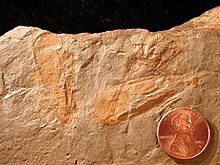Hyolith
| Hyolitha Temporal range: Fortunian to end Permian, 536–252.2 Ma |
|
|---|---|
 |
|
| Hyolithes cerops, Spence Shale, Idaho (Middle Cambrian) | |
| Scientific classification | |
| Kingdom: | Animalia |
| Informal group: | Lophophorata |
| Class: |
†Hyolitha Marek, 1963 |
| Orders | |
Hyoliths are animals with small conical shells, known as fossils from the Palaeozoic Era. They are lophophorates, a group which includes the brachiopods.
The calcareous – probably aragonitic – shells have a cover (operculum) and two curved supports known as helens, all of which grew by marginal accretion. Most are one to four centimeters in length and are triangular ormus elliptical in cross section. Some species have rings or stripes.
The orthothecid shell has an internal layer with a microstructure of transverse bundles, and an external layer comprising longitudinal bundles.
Helens are long structures that taper as they logarithmically coil gently in a ventral direction.
The helens were calcareous, with an organic component, and had an organic-rich central core surrounded by concentric laminae of calcite. They grew by the addition of new material at their base, on the cavity side, leaving growth lines. They were originally described by Walcott as separate fossils under the genus name Helenia, (Walcott's wife was named Helena and his daughter Helen); Bruce Runnegar adopted the name helen when they were recognized as part of the hyolith organism.
The operculum closes perfectly over the aperture of the shell, leaving two gaps through which the helens can protrude. It comprises two parts: the cardinal shield, a flat region at the top of the shell; and the conical shield, the bottom part, which is more conical. The inside of the shell bears a number of protrusions, notably the dorsal cardinal processes and the radially-arranged clavicles.
The hyoliths are divided into two orders, the Hyolithida and the Orthothecida.
Hyolitha have dorso-ventrally differentiated opercula, with the ventral surface of the shell extending forwards to form a shelf termed the ligula.
The Orthothecida are somewhat more problematic, and probably contain a number of non-hyoliths simply because they are so difficult to identify with confidence, especially if their operculum is absent. They have a straight (planar) opening, sometimes with a notch on the bottom side, and sealed with an operculum that has no ligula, clavicles, furrow or rooflets.
...
Wikipedia
